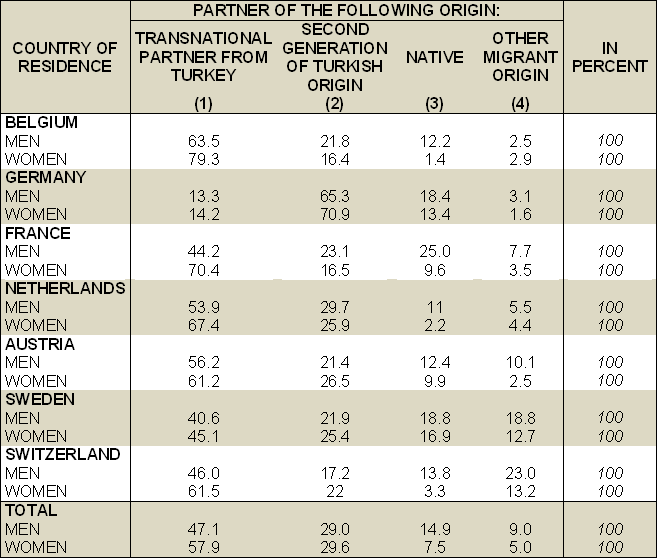In their article “Partner choice patterns among the descendants of Turkish immigrants in Europe”, Doreen Huschek, Helga de Valk and Aart Liefbroer examine how the institutional context as well as personal ties, such as family and peers, influence the partner choice of second-generation Turks.
Growing shares of European populations are made up of immigrants and their children. The consequences of this ethnic diversity have been the subject of much societal and scientific discussion. Nevertheless, relatively little is known about their preferences and behaviors in relation to family formation. This is particularly the case for the descendants of non-western immigrants who are now reaching adulthood in increasing numbers. Potentially different processes underlie the union formation choices of these young adults. They are faced with balancing potentially different values and behaviors on family formation: those derived from their parents and those from the country in which they grow up. How these different influences affect union formation remains unclear. It is also likely that structural constraints at the country or local level affect these union formation decisions, but little is known on these differences across countries.
In our paper, we look at the partner choice patterns of young second-generation adults of Turkish origin. They were born in Europe to mostly labor migrants from Turkey and are nowadays part of the largest migrant group in Europe (Eurostat 2010). We not only compare intermarriage with natives and endogamous marriage (e.g. marriage within own ethnic group), but also include the choice of a second-generation partner of the same origin or a partner of another migrant origin as important alternatives. Due to the changing composition of European populations, the Turkish second generation now has an increased chance of finding a partner among their own migrant community, as well as among other migrant groups, resulting in new partner options that were not available before.
To explore whether these new options result in new preferences or behaviours, we analysed data from “The Integration of the European Second-generation” survey (TIES) covering more than 3,000 young adults born to Turkish parents in Austria, Belgium, France, Germany, the Netherlands, Sweden, and Switzerland. We investigated contextual elements and personal ties as factors influencing the choice between four partner types (transnational partner from Turkey, Turkish second-generation partner, native partner and partner of another migrant origin, see Table 1).
There are many similarities in family formation between the descendants of Turkish migrants regardless of their country of birth. Cohabitation remains a marginal partnership form, and direct marriage is most common. Union formation typically occurs in the early twenties, and a large part of the second generation marries a partner originating from Turkey (with the majority of these partners migrating to Europe for the purpose of this relationship). However, in Germany the most common partner choice is someone from their own Turkish second-generation group (see Table 2).

Table 2. Partner choice of second-generation Turks by country of residence and gender in the TIES survey. Source: Huschek et al. 2012.
In the other six countries, this partner choice (among their own second-generation group) represents only the second or third most common choice of partnership type. A partner from another migrant group is a more common partner choice than the choice of a native partner. Both of these partner choices are more prevalent among Turkish second-generation men (compared with women). While a transnational marriage partner from Turkey continues to be the predominant choice, in some countries the combined percentages of the other three partner choices exceed this choice. This underlines that the other partner choices should not be ignored. Part of the preference for a transnational partner seems to be associated with the small number of second-generation Turks at the local level, which reduces the availability of potential partners. Furthermore, integration policies facilitating family reunion with spouses from Turkey remain one of the few legal migration options.
Beside contextual factors, such as the size of the marriage market and integration policies, we also considered how the second generation is influenced by members of their two main spheres of contact: their parents and (non-coethnic) peers. Generally, very little is known of the role of peers in union formation decisions among the second generation, although adolescents spend a large part of their time with age peers and friendships can develop into romantic relationships. Furthermore, particularly friendships with non-coethnic peers may reduce perceptions of differences between migrant communities and majority groups. However, for the partner choice of the second generation, parents may be particularly influential as they often attach a lot of importance to the Turkish origin of their children’s partner. This preference is found in particular among parents with more traditional family values and a preference for the family-initiated marriage system in which families introduce the potential partners. These parents often share characteristics such as a low level of human capital, large family size, rural origins and a strong religious background. Our findings are generally in line with these expectations and indicate that Turkish second-generation young adults whose parents show characteristics of the traditional family model and those with few non-coethnic peers at secondary school are more likely to have a transnational partner from Turkey. The opposite is found for second-generation Turks with a native or other migrant partner.
Author: Doreen Huschek is currently a postdoc at the University of Stockholm. The research article in spotlight is part of her dissertation “Union formation and partner choice of the second generation of Turkish origin in Europe: The influence of third parties and institutional context” at the Netherlands Interdisciplinary Demographic Institution (Nidi) and the VU University Amsterdam under the supervision of Aart Liefbroer (Nidi, VU University Amsterdam) and Helga de Valk (Nidi, Free University of Brussels).

